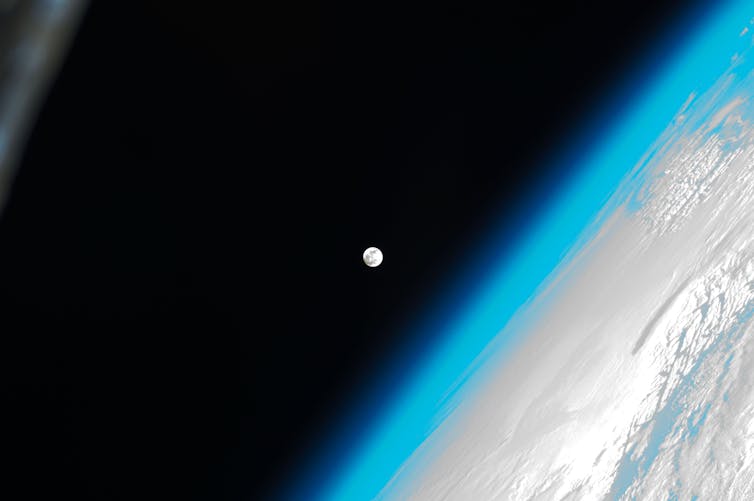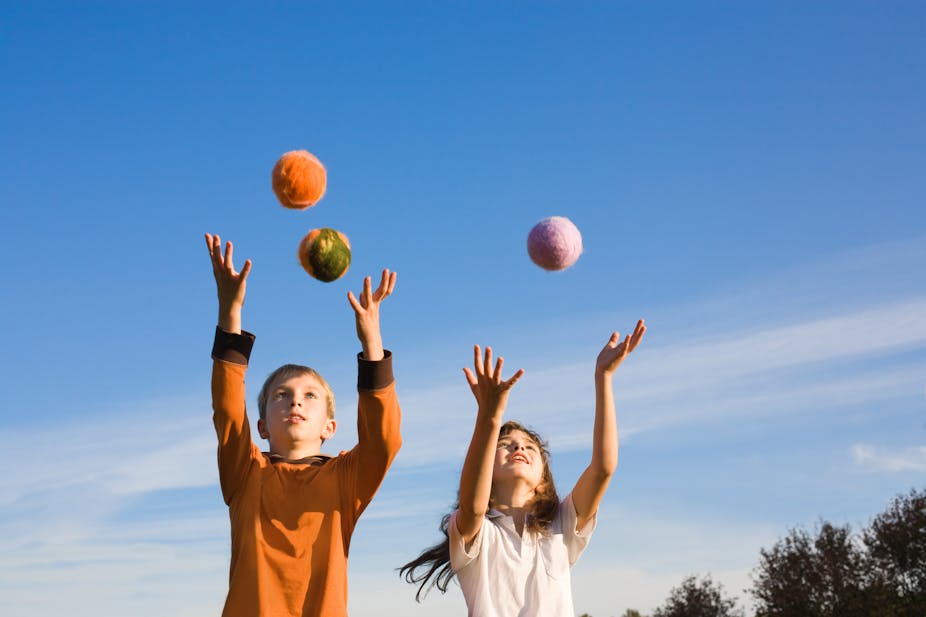This is an article from Curious Kids, a series for children of all ages. The Conversation is asking young people to send in questions they’d like an expert to answer. All questions are welcome: find details on how to enter at the bottom.
How does gravity pull things down to Earth? – Gabriel, age four, Stewartby, UK
Gravity is a force, which means that it pulls on things. But the Earth isn’t the only thing which has gravity. In fact, everything in the universe, big or little, has its own pull because of gravity – even you.
Isaac Newton was one of the first scientists to figure out the rules of how gravity behaves. The story goes, he was sitting under an apple tree when one of the fruits fell off. As he saw the apple fall down to the ground, he started to wonder why it didn’t go up to the sky instead.
After lots of experiments, and some very clever thinking, he worked out that the force of gravity depends on how heavy objects are, and that the pull of gravity between objects gets smaller, the further apart they are. To see how gravity works in our universe, we’re going to take a journey, with a few stops along the way.
First off, we’ll go to the park and play a game of football. When you kick the football into the air, the Earth’s gravity pulls it back down. But that’s not the only thing that’s happening: the gravity of the football is also pulling on the Earth. The thing is, the Earth is very heavy – much heavier than the football – so it’s unaffected by the pull of the football, while the football itself is pulled back down to Earth.
Our next stop is the moon, and as we journey up into space, there’s a good chance you’ll see the sun. Now, the sun is much, much bigger than the Earth, which means its pull is very powerful indeed.
You might be wondering why the Earth (and all the other planets) don’t just fall into the sun, the same way the football falls to Earth. The answer is that the planets are all moving, and the balance between the force of gravity and the speed of their movement (which comes from when they were first made, about 4.5 billion years ago) keeps them circling round the sun.

When we arrive on the moon, you’ll see that the pull of gravity is not the same everywhere. It is related to how heavy – or how massive – an object is. If you jump on the moon, you’ll be able to go much higher than you can on Earth. This is because the Earth is bigger than the moon, so the force between you and the Earth – which is what we call weight – is bigger than the force between you and the moon. On the moon, you seem to weigh less than on Earth, so you can jump higher.
Our final stop is the seaside. Sitting on the beach, you can see the sea gradually getting closer and closer to you – this is the tide coming in. After some time, the sea seems to get further away – now, the tide is going out. But the sea is not actually moving in and out – it is moving up and down. As the sea level rises, the water gets closer to you, because the beach you are sitting on slopes upwards away from the sea. And as as the sea level drops down, the water gets further away from you.
This is also an effect of gravity, and it happens because the moon is close to the Earth. Unlike the football, the moon is heavy enough to have an effect – just a little one, because the Earth is still much heavier – but it’s enough for us to notice when we watch the tides. As the water level rises, it is being pulled towards the moon, and the tide comes in. Then the tide goes out, and the water level drops, as the moon rotates around the Earth.
An interesting question is why we don’t have enormous tides caused by the sun pulling on the Earth. We know that the sun is much bigger than the moon – so surely it ought to be able to pull water towards it? Actually, it does – but much less than the moon. This is because although the sun is much bigger than the moon, it is much, much further away – and the pull of gravity gets weaker the bigger the distance between objects.
So, next time you’re kicking a football around in the park, you’ll know how gravity is bringing the football back down to Earth.
Hello, curious kids! Have you got a question you’d like an expert to answer? Ask an adult to send your question to us. You can:
* Email your question to curiouskids@theconversation.com
* Tell us on Twitter by tagging @ConversationUK with the hashtag #curiouskids, or
* Message us on Facebook.

Please tell us your name, age and which town or city you live in. You can send an audio recording of your question too, if you want. Send as many questions as you like! We won’t be able to answer every question, but we will do our best.
More Curious Kids articles, written by academic experts:
How do SIM cards make a phone work? – Leo, age five, Sydney, Australia
What’s it like to be a fighter pilot? – Torben, age eight, Sussex, UK
This article has been updated to more clearly describe the effect of gravity between the Earth, the moon and the football, as well as the movement of the planets.

